7 Classics That Offer the Most Horsepower Per Dollar
We track thousands of cars for the Hagerty Price Guide. Values range from four figures to eight, and performance ranges from single-digit horsepower to over a thousand. If you’re looking for the most bang for your buck, you might be wondering what’s the most amount of factory-rated horsepower you can get for the least amount of money. We wondered that, too, so we dug into the data, looking at horsepower ratings relative to condition #2 (“Excellent”) Hagerty Price Guide values.
For reference, the list of worst deals in terms of cost per horsepower includes, predictably, a Ferrari 250 GTO. For each of that car’s 300 ponies you’ll pay over $213K. A McLaren F1’s horses cost $35K each. Improving the ratio dramatically but still not a bargain, Porsche 911 Carreras from the ’80s cost more than $400 per hp, and a Corvette C5 Z06 costs $95. Way down the ladder, the cheapest power in the collector car market comes in around $25–$35 per horse.
A few themes emerged—big coupes and sedans figure prominently, as do cars that find themselves adjacent to truly lusted-after models. And, as always with data, there’s a result that technically answers the question without addressing the spirit of the effort. With that context, here are seven cars that offer some of the cheapest horsepower out there.
1970 Buick Wildcat
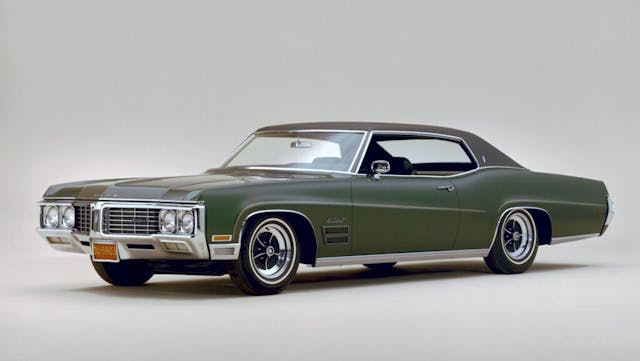
Buick’s 455-cubic-inch V-8 is a torque monster, and power is ample, even accounting for 1970’s gross (rather than net) horsepower ratings. The 370 horses the 455 cranked out in the ’70 Wildcat is quite a bit, no matter how you’re measuring.
At $10,200 for a #2 condition example, this personal luxury coupe is stylish and relatively affordable. The Wildcat may be Buick’s best answer to this question, blending the traditional image of what makes a classic car with a solid $27-per-horse ratio. With that said, you can get a 315-horse 455 in a 1971 Buick Estate Wagon, and at $7800 for one in #2 condition, that model tops our list with the most affordable ratio of all: $24.76/hp.
1996–99 Ford Taurus SHO
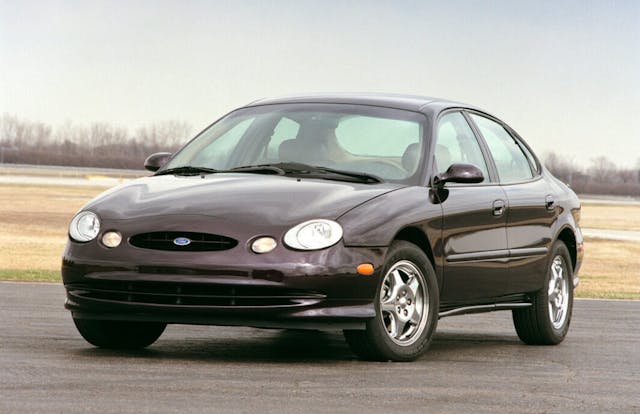
Ford’s four-figure factory hot rod with a Japanese heart, the first-generation Taurus SHO has long been one of the cheapest ways into a modern classic that’s fun but still practical. The first-gen car is cheap, but in terms of pure ponies per buck, it’s not quite the bargain that is the third generation.
When that Taurus came out in 1996, it embraced the melted jellybean style of the 1990s and early 2000s and was both bigger and softer than its predecessors. It also only came with an automatic. Even so, the Yamaha engine under the gentle curves of that hood was now a V-8 (with a block by Cosworth, no less). It wasn’t a good seller, and Ford canceled the SHO when it introduced the fourth-gen Taurus. The SHO’s V-8 is rated at 235 hp, which isn’t anything to write home about, but the car’s #2 value is just $8000. That comes out to $34 per horsepower.
1962–70 Chrysler 300 Sedan
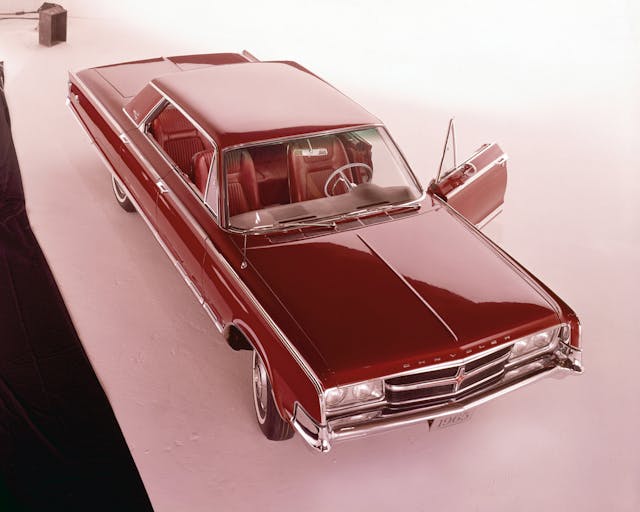
Chrysler’s 300 badge spans nearly 70 years, lots of very different cars, and several price points. The original “Letter Series” Chrysler 300s are some of the most attractive and collectible American cars of the 1950s. The modern one, which finally ended production last year, offered performance and luxury at an attainable price. And, as Katt Williams says, it “do look like a [Rolls-Royce] Phantom … until a Phantom pull up.”
Falling in the middle are the “non-letter series” cars of the 1960s. A full-size model that comes as a four-door hardtop, two-door hardtop, or convertible, it’s also a model whose values have been pretty sleepy in the market. This is particularly true of the sedans: Over the past 15 years, their values haven’t kept up with inflation. Values for some model years have appreciated just 11 percent in that period. That means they’re cheap today, with #2 values around 10 or 11 grand.
Since they came with the same 383-, 413- and 440-cubic-inch V-8s as the sexier, more valuable two-door models, sedans offer more bang for the buck. Some of the later 440/350-hp and 440/375-hp cars have pricier ponies at $35 or $36 per hp, some of the 413/360-hp and 383/315-hp cars can be had for as little as $31/hp.
1985–88 Cadillac Cimarron (V-6)
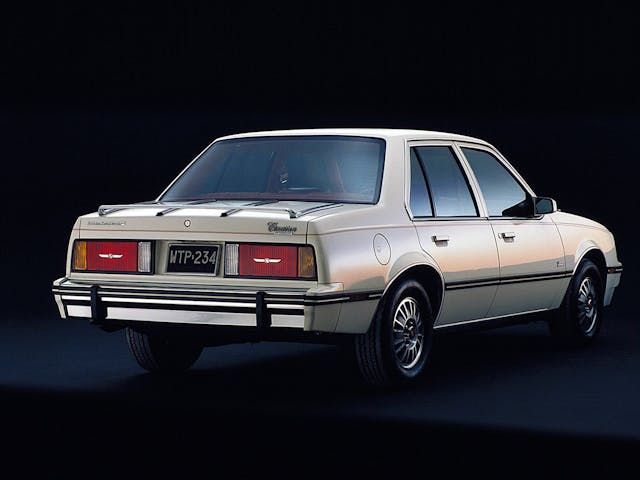
The Cimarron is the polar opposite of the Ferrari GTO in almost every way, including the way the dollar-to-horsepower ratio is skewed. Technically, the Cimarron offers more power per dollar than almost any car on the road because, it’s just so cheap. The median #2 value for this gussied-up Cavalier that the ads called “The Cadillac of Smaller Cars” is just $3600. Final-year 1988 models, though, hit a wallet-stretching $4100.
Later ones got a 125-hp V-6 and nifty (now retro) digital gauges, and from a bang-for-buck perspective the 1986–87 models are the sweet spot. They’re just $29/hp.
1996 Pontiac Firebird/Chevrolet Camaro (V-6)
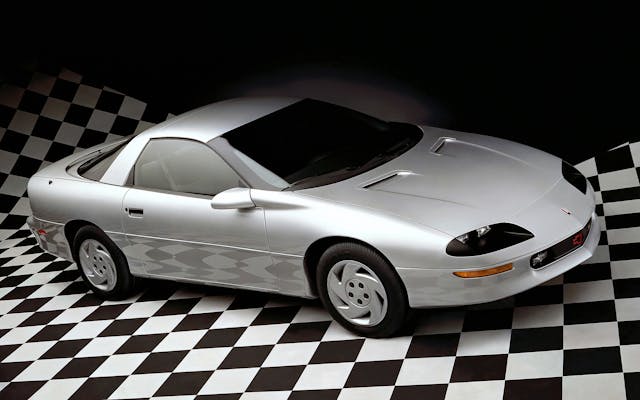
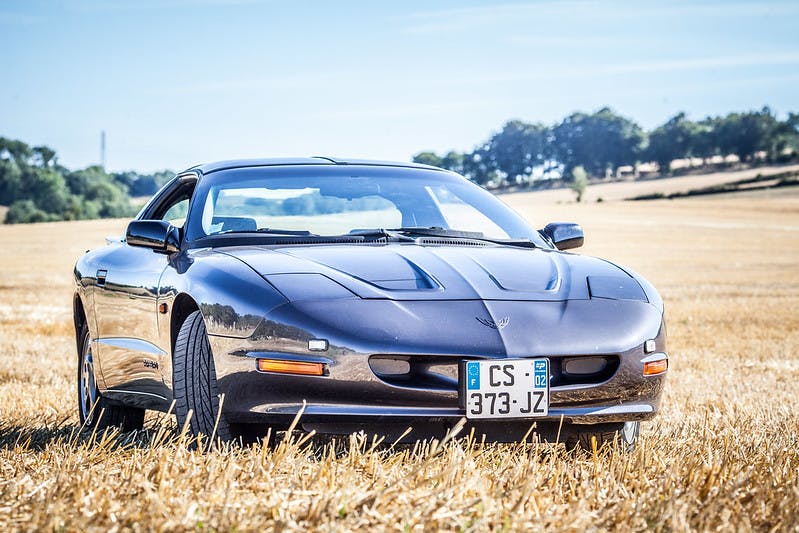
Trans Am, WS6, Firehawk, Z28, SS—those are the names fondly remembered by F-body fans and the models most sought after now that they’re modern collector cars, but the bulk of fourth generation Firebird/Camaro production were base models with a V-6, which came in both 3.4- and 3.8-liter displacements.
All V-6 Camaros and Firebirds are cheap, but in terms of bang for buck the 1996 Camaro and Firebird V-6 coupes take the cake. They’re rated at 200 hp and their condition #2 value is $5500, which comes out to $27.50 per pony.
1970 Chrysler Newport Sedan
The fifth-generation Newport came out in 1969, adopting the fuselage styling that characterized full-sized Chryslers for the next few years. It’s handsome, roomy, and comfortable. But don’t take it from me, take it from Willie Mays (in the commercial above).
While it lacked the decals and High Impact paint colors that made Mopar muscle cars so flamboyant, the Newport nevertheless came with muscle car grunt, as a 440/375-hp V-8 was available. Today, the 1970 sedan model with that engine brings serious power for not-so-serious money. Its condition #2 value is just $10,600, which comes out to a little over $28 per hp.
1992–97 Cadillac Seville STS
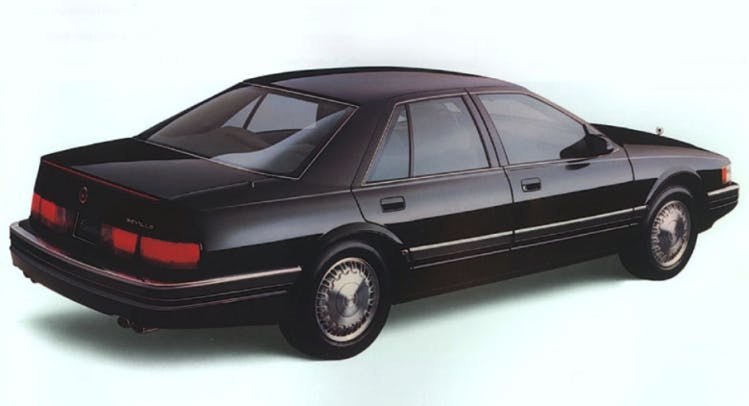
The ’90s weren’t Cadillac’s golden age, but the STS (“Seville Touring Sedan”) did win Motor Trend’s Car of the Year in 1992, and from 1993 the model got the 32-valve Northstar V-8 engine, which offered up to 300 hp.
An STS cost 40 grand or more in its day, but the #2 value for one now is typically under nine grand. Depending on year, it come out to about $30 per hp.
***
Check out the Hagerty Media homepage so you don’t miss a single story, or better yet, bookmark it. To get our best stories delivered right to your inbox, subscribe to our newsletters.
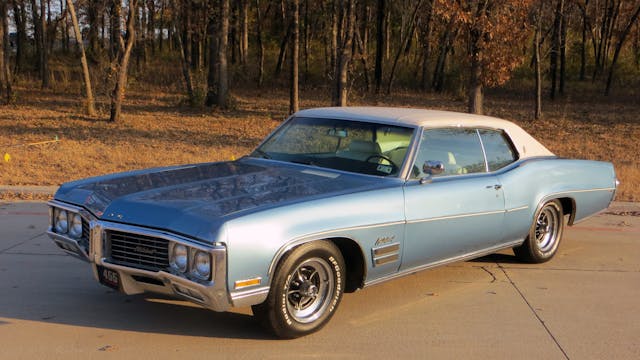


Price per horsepower? Hmmm…How much for a 86 Snapper ride-on mower? They are rear engined like a 911.
Got one and I’ll take $1000 for it
I thought the 70 Eldorado would have made the list, but the #2 values are a bit higher than I expected at around 40K ($90/hp)
I am a GM guy but a V6 f body or Cimarron? Not sure about that.
Cobalt turbo or HHR SS you can easily get 300 hp light weight and less than $10k.
Camaro did have an optional V6 Performance Package option that provided lower gearing, dual exhaust and a manual transmission………woke it up slightly. A good value even when new for an entry level sporty car….
Still does not fit the most hp per dollar. The V8 cars are not much more and better fit the title.
You have to be kidding me – Cadillac Cimarron, these were the biggest POS cars around! Chevy Citation with electric seats and a Cadillac badge – I think these had either the 4 or 6cyl engines. Nothing special about these at all and not exactly a speed demon for sure! Now the FireHawks were another story!
chevy cavalier
You’re rite. They are garbage
When I was growing up my father had a ’65 Chrysler Newport 4 door sedan with a run of the mill 383 2Bbl, this, of course, after the ’64 Plymouth Sport Fury. The Newport was a responsive, sensible family car but my father set his sights on a ’66 300 2 door hardtop and two years later a ’68 300 4 door hardtop with the 375HP ,440 TNT engine. That, along with my uncle’s Buick Electra 225 with the 455 4Bbl were amazing cars. They had an exhaust note that sounded a hint of menace out of their dual exhausts with mufflers and resonators on both sides but despite their curb weights in the 4,400lb range were really able to move! Both cars were excellent off the line but their most impressive power showed when accelerating from 50 MPH to 80 MPH. Accelerator to the floor in the 300 dropped the transmission into second, the vacuum built quickly and secondaries opened and it pulled like an electric motor, the Buick was a little different, quick downshift, then the secondary doors opened and it powered forward, leaving the passed car behind in a few seconds. It was a great time to be a 10 year old boy that liked cars. For what it’s worth, I have a ’67 Plymouth Sport Fury with the Super Commando 440 (Plymouth’s version of the TNT) and a 4 speed manual, gee, I wonder why…
Had a Newport back in the day, biggest car I’ve ever owned. Parked at night with the headlights on, small aircraft would try to land on the hood. Almost needed a walkie-talkie to talk to rear-seat passengers LOL! Loved it for what it was anyway.
now THAT’S funny 😁
My dad had a ’62 Wildcat (first year) with the 401 nail head, a huge carb and the standard Dynaflush transmission. I used to pull off the air cleaner so you could hear the secondaries open when I “borrowed” it to cruise in. I spent my junior year in high school blowing a lot of street racers away in that beast. I later owned a couple of ’55 Buicks. A Special with a 264 nail head and a Century with a heavily modified 352 nail head (it was originally a 322). They were all stump pullers at the low end. The 401 and the 352 particularly. The Century had been built professionally at a highly regarded local speed shop and the PO had converted it to a 3 speed stick with 4.45 gears. He successfully raced it all over Northern California drag strips as a C “stock” car before he sold it to me when I was 19. I owned it for a year and that’s when I became a “car guy”.
My first car was a ‘66 Newport sedan. Drove it nearly 10 years. Had the 383 2bbl and was a fantastic road car.
Cimarron, I laughed. No tarted up Cavalier for me.
The V8 Taurus SHO was a disappointment compared to the previous V6. It was a cool engine idea but not particularly better than the V6.
Love the Wildcat. But why would I want a swollen 1971 Buick Estate Wagon, when I could get a 1970 Estate Wagon with the trimmer-looking previous body style, and the same high-compression 455 as the Wildcat?
Dad bought a ‘69 wildcat new. Maroon with a white interior. He would say it liked to cruise at 82mph across west Texas.
Wrong image for First Gen Taurus SHO…
They are speaking about the 3rd Generation SHO. The image is correct.
BillyBobs good catch on the incorrect photo. Had a 1988 Sable Wagon, always wished Ford would had offered that as a SHO option. Oh well…
What a fun angle for an article! Love it!
Wildcat ? OK, but what about the GS Stage 1 ?
Not sure where you’re finding #2 condition 1970 Buick Wildcats for $10,200? Late 60’s Buick barcoloungers are still a great value at twice that price.
Very interesting! I bought my Porsche 356B Cabriolet at $ 35.81/HP. It would cost me $2,364.86/HP today. That’s using today’s SAE net HP at the rear wheels and exceptional condition. There’s an insignificant difference using SAE HP at the flywheel that the factory advertised. I think I have some mixed feelings about this, Love the appreciation, hate the current high cost/low HP. Love that I can cruise at 80+ with the 911s on a rally, hate that I have to check the rear view mirror to see if my engine is somewhere in back of me when leaving the toll booth.
I would like to see an article comparison between speed performance vs. cost.
I’m considering a performance car to scratch my “middle-age” itch.
I prefer a more modern vehicle that can easily be a daily driver during nice weather, but command some respectful performance. I am partial to V-8 power since I grew up in that era, but I’m open to others.
I am not a big fan of vehicles other than U.S. Companies like the big three, but once more I can keep an open mind.
Possible Candidates…
’01-’02 Pontiac Trans Am (LS1 V-8)
’05-’06 Pontiac GTO (LS2 V-8)
’07-’09 Pontiac G8 GT (L76 V-8)
’14-’17 Chevrolet SS (LS3 V-8)
I’m not limiting myself solely to GM vehicles. These examples have just peaked my interest since they all can command low 13’s quarter mile specs.
I’m sure there are many others that I have not placed much attention to.
Thanks,
Curt in Ohio
Agree on your logic of performance vs. cost. Your list is good and I previously hunted the “modern” GTO but bought a 2001 Cobra Mustang (DOHC) with IRS. This car could be on the list with other GMs, such as CTS-Vs and ATS-Vs, CT4 / CT6-Vs and Mustang GT’s from 2011 – 2018 riding down their depreciation curves.
piqued
Got my ’99 STS for $1200 a little over 3 yrs ago with 113K on it, now has 130K. 2 previous owners & the 2nd one never drove it in the winter (neither have I). One wheel bearing & rotors is all I’ve done to it. Love the look so much I got a ’99 Eldorado for $1900 to go with it! Have had no issues with either of them as far as the Northstar engine goes. 275-300 hp & seen over 30 mpg several times with both of them,
Strange to the missing activities of Studebaker during the Fall of 1963 wheere many records were set with many still standing.
Looks like I’ll be going to a new insurance provider when my current coverage runs out…
Avantis seem to be selling for over $50,000 these days. That would make the cost per horsepower well above the vehicles in this list. Gran Turismo Hawks are cheaper, but the ones I see on the market have a 289 engine. Not much bang for the buck. Taking your business elsewhere because your favorite car wasn’t mentioned in a “best deals” article seems a bit childish to me.
George, you need to read his comment again.
Yep
His comment is attached to an article about cars that provide the most horsepower per dollar. Early ’60s Studes don’t.